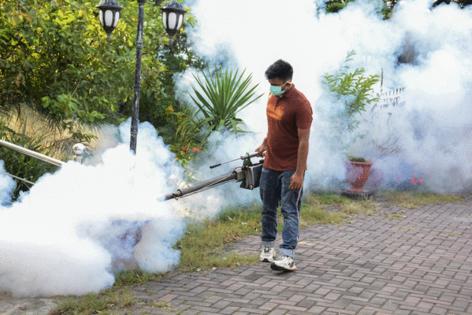Lara Williams: Iceland's new bloodsuckers are a warning to us all
Published in Op Eds
If you want to live somewhere without mosquitoes, you’re running out of options. One of the world’s last remaining mosquito-free zones has been infiltrated by the bloodsuckers.
Three specimens of Culiseta annulata were found in the southwest of Iceland, leaving Antarctica as the only remaining refuge from the biters.
Scientists will be monitoring the situation to see whether the trio are a fluke or the start of an established breeding population. Culiseta annulata is a species already well adapted to colder temperatures – we have them here in the UK – so it’s plausible that it could easily gain a foothold in the remote island nation.
The discovery tells us just how readily mosquitoes are being transported around the world. Given that Iceland is roughly 800 miles (1,300 kilometers) away from Scotland, the closest location with an established population of Culiseta annulata, the mosquitoes must have been introduced via plane or ship.
As climates warm, and we continue to trade goods and travel, tiny hitchhikers are bound to make their way to new places. From then, if the conditions are right, it’s remarkable how quickly a population can survive and establish itself, as Iceland has discovered.
About 10 years ago, Iceland’s public broadcaster RUV reported that “a new aggressive bloodsucker…bit and drew blood from numerous people enjoying the summer weather in Kjós. The bites cause intense itching and rashes.” The culprit? The biting midge, also known as lúsmý in Icelandic and “no-see-ums” in the UK. In the following years, the miniscule nuisances spread across the nation, irritating locals and tourists alike – there’s even a song.
Biting midges are more irritating than dangerous, and Culiseta annulata is also not known to spread disease, so Iceland will be itchier but ultimately safe. Other parts of Europe aren’t quite so lucky.
Aedes albopictus, or the tiger mosquito, has spread across the continent in recent years, exploiting warmer temperatures and milder winters to establish itself in 16 countries.
The species can transmit a range of tropical vector-borne diseases, and in August the European Centre for Disease Prevention and Control reported that Europe had seen a record 27 chikungunya outbreaks so far in 2025, with the first locally acquired case reported in France’s Alsace region, an “exceptional occurrence” for that latitude, emphasizing the northward spread of the virus. As of October 22, France and Italy reported a total of 1,124 cases. There have also been multiple outbreaks of locally acquired dengue and West Nile virus infections.
For the UK, it’s only a matter of time until the continent’s problems become our own. Eggs of Aedes aegypti, another mosquito capable of spreading arboviruses like dengue and Zika, were discovered in a trap at a freight depot near Heathrow airport – the first time we’ve seen evidence of them breeding in the UK. Tiger mosquito eggs were also found in August 2024 at a service station in Kent.
Marcus Blagrove, a senior lecturer at the University of Liverpool, explained to me that temperature plays two roles in vector-spread diseases. The first is making the environment suitable for the mozzies in the first place. The second is aiding the virus’s ability to multiply. Not only is climate change giving us more mosquitoes, but those mosquitoes are packed with thriving viruses that are ready to be transmitted.
Blagrove’s research shows that our native mosquitoes are also capable of spreading some non-endemic viruses such as the closely related Usutu and West Nile viruses at summer temperatures. Usutu tends to only infect birds, but Blagrove describes it as an “early warning” for the much more dangerous West Nile virus, which follows as temperatures rise further.
Given that Usutu was first detected in London blackbirds in 2020, and has been found in birds or mosquitoes every year since, it’s a matter of when, not if, West Nile follows. Modeling from the UK Centre for Ecology and Hydrology, Biomathematics and Statistics Scotland and the University of Glasgow found that the risk will increase in the next two decades.
Though the advance of mosquitoes and their diseases are inevitable, particularly as we keep pumping carbon dioxide into the atmosphere, there’s a lot we can do to prepare. The UKHSA has an extensive surveillance program to detect invasive species and prevent their establishment, while the UK government has invested £7 million ($9 million) in research into vector-borne diseases, which includes Blagrove’s West Nile and Usutu studies.
But that momentum must be kept up. The more we understand how mosquitoes are living in new places, the better we’ll be able to keep their numbers under control.
For example, if we know that they like to lay their eggs in pothole puddles, then there’s another great reason for the government to fill them in. Likewise, the quicker we can get vaccines for dengue, chikungunya and Zika on the market, the better – both for regions where the pathogens are already endemic and to prevent travelers unwittingly bringing them back for our home-grown mosquitoes to pass on.
In the meantime, we should all be more vigilant about not getting bitten – both at home and away.
_____
This column reflects the personal views of the author and does not necessarily reflect the opinion of the editorial board or Bloomberg LP and its owners.
Lara Williams is a Bloomberg Opinion columnist covering climate change.
_____
©2025 Bloomberg L.P. Visit bloomberg.com/opinion. Distributed by Tribune Content Agency, LLC.
























































Comments